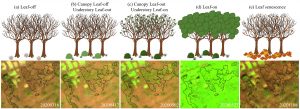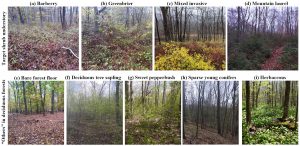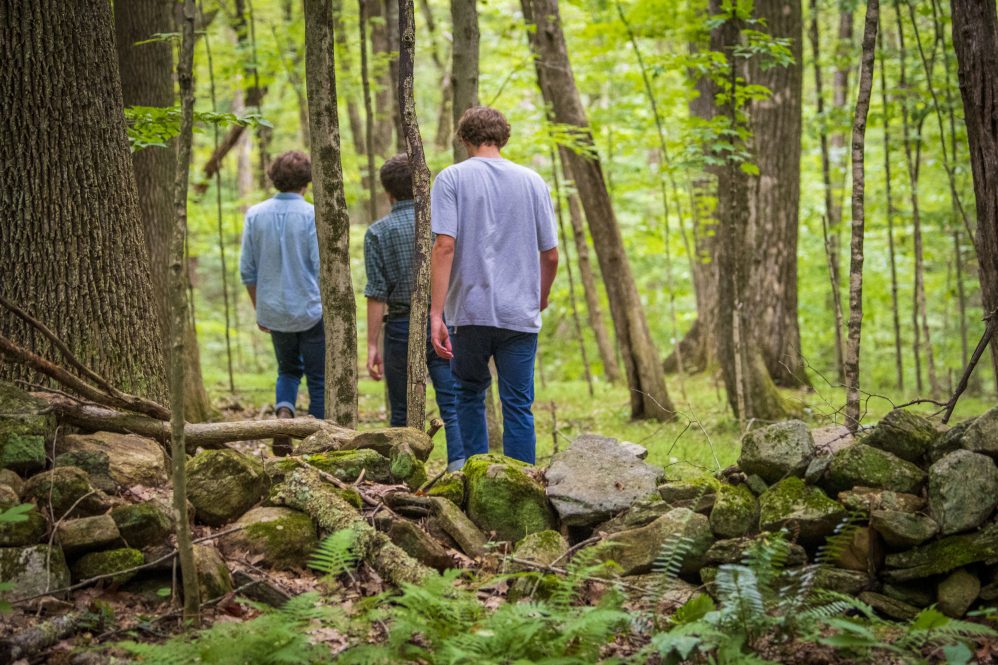Distinguishing separate plant species from one another is hard even for human eyes; however, a team of UConn researchers was able to use data from a satellite nearly 500 miles (786km) above Earth’s surface to map Connecticut’s forest understory plant communities. The results of this study are published in Remote Sensing of Environment.
The understory, or what grows beneath the canopy, is a crucial part of the forest ecosystem. From providing habitat and food for animals, to cycling nutrients, to acting as a nursery for younger trees that will one day become the canopy, the understory plays essential roles in a healthy forest.
One species that depends on certain understory habitats is the New England Cottontail rabbit and Assistant Professor in Residence Chadwick Rittenhouse, a researcher in the Department of Natural Resources and the Environment in UConn’s College of Agriculture, Health and Natural Resources was interested in locating areas that could support Cottontails to monitor their dwindling populations. Curious about potential methods to track these habitats down, he spoke with Zhe Zhu, the director of UConn’s Global Environmental Remote Sensing Laboratory (GERS), to see if remote sensing technologies could help.
Zhu notes the challenge of tackling this question using remote sensing is in figuring out how to use satellite technology to see what is happening beneath the tree canopy.

The researchers started by focusing on a few one-kilometer by one-kilometer plots for a pilot study. Shi Qiu, Research Assistant Professor in the Department of Natural Resources and the Environment, explains the process of finding the right method for capturing the required data:
“We compared data from different satellites which have different spatial resolutions. For example, Landsat is a popular satellite with a 30-meter resolution. On our first try, we found the resolution was not good enough, so we switched to a higher spatial resolution and found good resolution with Sentinel-2, which has a 10-meter resolution.”
With the right sensors identified, the researchers found a temporal gap they call the “observation window,” after understory plants have greened up but right before the trees leaf out, says Zhu.
“The plants in the understory grow earlier to get enough sunlight before the tree leaves close the canopy above. We have this precious observation window to see the understory. We were not only able to locate where those understory species are but also the understory species within the community with high accuracy.”
The researchers developed a strategy that distinguished plant species with an overall accuracy of 93% and determined that around 53% of Connecticut’s understory is now comprised of invasive plant species like barberry, bittersweet, winged euonymus (burning bush), and multi-flora rose.
Natural Resources and the Environment post-doctoral researcher and first author of the paper, Xiucheng Yang, explains some of the key aspects that made this possible:
“The major way we were able to distinguish the different understory communities was because we could see the different phenology of the understory communities, basically, we know that different vegetation has different dates when they leaf out and grow. For instance, some kinds of plants like mountain laurel are evergreen, but some kinds of plants like barberry or the native greenbriar, have different dates when they start to become green. We also understand more spatial information (e.g., texture) of different vegetation, for different kinds of species, there may be different kinds of spatial pattern features.”

The researchers were also able to rely on the fact that different plants reflect light back at different wavelengths outside of the visible spectrum, and this spectral data provides a lot more information about vegetation, says Zhu.
Knowing the method works, the next step is to explore potential applications, says Rittenhouse. For instance, by tracking invasive plants, it may be possible to track disease-carrying ticks that find refuge in invasive plants like the black-legged tick which favors the dense habitats created by masses of barberry.
“There’s an obvious human health component to being able to identify where we have a high prevalence of barberry,” Rittenhouse says. “But also, because of the dense growth pattern, barberry can inhibit the growth of native understory species and tree species. One can envision a peek into the future where current forests are senescing. Trees have certain lifespans but if there’s no forest growing up underneath because of that dense mat of barberry, there are significant implications for how we manage our forests and what kinds of forests we might have in the future.”
Rittenhouse points out that all of this is happening in a context where, across the region, forests are losing trees to various diseases and pests, including the emerald ash borer, beech leaf disease, and the loss of many oaks due to spongy moths. If there are no young trees growing in the understory, there will be no trees to replace the gaps in the canopy.
Natural Resources and the Environment master’s student Mari Cullerton is now working to construct maps from 2015 to the present to create change detection maps to see if changes in the understory plant community can be detected over time, and hopefully updated annually.
“For this project, we don’t necessarily care what species the understory is, we just care whether we can see a change,” says Cullerton. “For instance, if there’s an invasive treatment where people remove plants such as barberry from the understory, can we see that change in the Sentinel-2 imagery? With the 10-meter resolution, it’s incredibly difficult because there are a lot of factors that influence the understory, such as differences in the phenology of the canopy above. If we have a late or early spring leaf out, the algorithm can detect leafing out early or late and it thinks that’s a change, but those plants are still there, it’s just a difference in phenology. That’s one major issue and we can solve it by using spatial data normalization, essentially comparing pixels around a central pixel to determine whether the changes were seen over large areas such as an early spring, or if it’s just that pixel, which is likely an indication of an understory change.”
Initially, Zhu says the researchers were not sure they could construct such a precise map, and they are thrilled with the results.
“This is one of the largest understory species mapping activities ever in remote sensing history and I think there are a lot of things we can do with this kind of product, in addition to studying wildlife habitat.”
The final maps can be accessed interactively here.
Rittenhouse credits the success to the power of collaboration:
“When you have this many people thinking deeply about a topic and trying to figure it out, it is a real benefit to have this wonderful collaboration that we have. I’m an ecologist by training, so I benefit tremendously from this collaboration and working with so many talented people who can do the things when I have an idea, and they figure out how to make it happen.”
This project was funded by a grant from the Connecticut Department of Energy and Environmental Protection, Wildlife Division.



